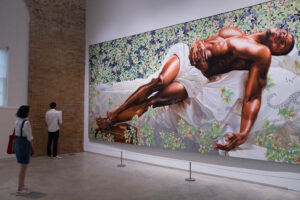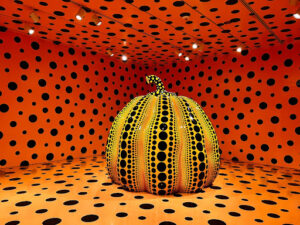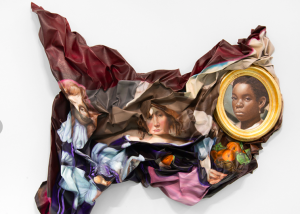“Families are forever—in the good, the bad, and the spaces in between.” These words appear alongside artist Ruth Leonela Buentello’s work at the National Portrait Gallery. Her dynamic portraiture is part of the Gallery’s Kinship exhibit, the latest in their “Portraiture Now” series.
Featuring eight contemporary artists, Kinship depicts the complexities of human relationships through various media, emphasizing different perspectives on intimate interactions. The placement of the works and contrasts between rooms—from colorful wallpaper to monochromatic art pieces to door jambs—accentuate the roles of storytelling and memories in connecting different generations, cultures, and families. Encompassing both the living and the dead, time is the string connecting all of the works.
Buentello’s artwork is exhibited in a room awash with pink, her vibrant pieces distinct against floral wallpaper. Her paintings have 3D elements with the inclusion of telas, or fabrics, such as emerald ribbon adorning the edge of “Under the Mexican Colchas” (2012). This multimedia art immerses the viewer in a homey, warm room, surrounded by a family sitting with and hugging each other, exploring kinship through moments of shared silence.
The Kinship project started in 2018, and the separation and loss that followed during the pandemic provided a new angle for the exhibition: finding hope in darkness. Portraiture as an art form shows the vulnerability and private moments of families, but also the community that unites us.
When I entered the exhibit, I was struck by the room immediately to the left, housing Njideka Akunyili Crosby’s lively work. One portrait, “Nkem” (2012), displays her partner wearing his “senator suit” from their wedding. The traditional Igbo and Niger Delta garments are mixed with the fabric found in European formal wear. Collaged onto his body are numerous images of American pop culture influences contrasted with the couple’s Nigerian culture. Another portrait displays Crosby and her siblings, alongside one of Thelma Golden, a recognized authority in art by those of African descent. In her words, these portraits “touch upon the various ways we become kin.”
The next room in the exhibit dramatically contrasted Crosby’s colorful works, featuring a series of black-and-white photographs that make up LaToya Ruby Frazier’s “Flint is Family in Three Acts” (2016-21). Frazier depicts Flint, Michigan creative Shea Cobb and her family—whom she views as “kindred spirits”—as they struggle through the Flint Water Crisis, mirroring Frazier’s own experience with toxic pollution in Braddock, Pennsylvania. Small frames hold images of Cobb’s son rinsing his mouth with bottled water and a satellite view of the town. Next to them is a larger, staged portrait of Cobb’s family staring directly at the viewer. Their humanity shines through the raw pain of the portraits, highlighting their united front fighting for accountability in government. These parallels continued through the exhibit, ending with people able to drink water in their hands from a small, flowing stream and Cobb standing in her living room a year later. While its monochrome coloration created a sense of solemn distance from the crisis, this archive acts as a reminder of the Cobb family victory in the eventual indictment of the officials.
Crossing over to the right side of the exhibit, the portraits take on a different tone. Anna Tsouhlarakis’ “Portrait of an Indigenous Womxn [Removed]” (2021) renders a missing person poster framed by beads, representing one of many missing Indigenous women. Although Tsouhlarakis’ kinship and love for the larger Native community are predominant in her work, her project does not solely focus on the topic. Rather, as a part of the Navajo Nation, she aims to amplify the incomplete stories of these lost Native women, and illuminate how these overlooked tragedies affect the community, presenting another kind of kinship: one with those who are suffering.
The next room depicts Sedrick Huckaby’s kinship with people who come from the same home. Though kinship often has a strong physical presence, Huckaby’s work illustrates how it can extend to a spiritual level. “Connection” (2020) surpasses the 2D space to depict a connection between the living and dead. The oil painting on the wall presents an abstract figure with a skull for a face, foregrounded by a childlike sculpture made of newspaper papier-mache sitting atop a desk chair on a wooden platform. Hunched over, the child holds a piece of cardboard in the shape of a book. This piece masterfully bends the restrictions of time and distance, and shows a kinship that extends across lives, hidden as a result of time but strongly bound together nonetheless.
Jess T. Dugan’s work examines time passing across generations of her family. Her photographs capture cherished moments among family. Spread across the walls at eye level, they confront the viewer with their intimate subjects. Many portraits mirror each other: One photograph shows Dugan embracing her child while another has her partner, Vanessa, holding their child in an outdoor shower. Another duo on opposite walls depicts Dugan embracing her wife in bed and Dugan resting her head on her mother’s lap. While Dugan’s work is more explicitly a statement about the lack of queer family representation in cultural spaces, the strength in familial vulnerability expressed by these photographs is a theme echoed by all eight artists.
The hallway connecting the six rooms presents Thomas Holton’s evocative photography. Holton always felt a disconnection between the clashing sides of his identity—his Chinese heritage and American upbringing. In 2003, he met the Lams, a Chinese family living in NYC that accepted Holton into their home and demonstrated the possibility of connecting both sides of his culture. That sense of belonging became the foundation for Holton’s definition of kinship. Through his photographs, he presents intimate moments between both worlds: family meals around the table, moments of boredom in their Manhattan apartment, the Lam children with their passports. As I looked at one of the children, all grown up and sitting in his new college dorm, I realized how much the family transformed as the years passed. But that belonging—to family and culture—is constant. It never dissipated, becoming Holton’s kinship.
While Kinship includes eight definitions of the titular theme, one throughline connects them all: When fear creeps in, sadness falls upon us like a wave, or anger fights and roars, kinship is the backbone for how we take on life.




